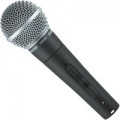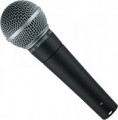—
Wireless connection. This feature is indicated for the so-called radio microphones — models in which the signal is transmitted wirelessly. Note that a radio microphone kit usually involves a receiver that is connected to an amplifier (or other sound processing device) in a classic wired way (see "Connection connectors"). However, the microphone itself is connected to the receiver via a radio channel.
—
Stereo recording. The ability to use a microphone to record sound in stereo format. This format assumes the presence of two channels, and for each of them the sound must be recorded separately; but the technical support of such a recording in different cases may vary. The most popular option is bi-directional microphones. However, in addition to this, this category includes paired sets for which the stereo recording function is directly claimed.
—
LPF (Roll-off). The presence of a low-pass filter in the design of the microphone (Roll-off is an alternative name for this function). This feature allows you to reduce the level of low frequencies in the signal produced by the microphone. This need may be due to two factors. Firstly, many extraneous noises are the sound of the wind, knocks on the device case, the surrounding background, etc. — are presented at low frequencies; by suppressing this range, you can significantly reduce the level of extraneous so
...unds “heard” through the microphone. Secondly, the LPF is useful for working with the so-called "proximity effect". This effect consists in the fact that when approaching the sound source, many models tend to increase the volume of the bass sound, and when removed, on the contrary, they fail the “bass”. By turning on Roll-off when approaching the sound source and turning it off when moving away, this effect can be smoothed out to a certain extent. For a number of technical reasons, this function is mainly used in condenser and electret microphones (see "Type"). Note that in advanced models, the low-pass filter can be made customizable and supplemented with an auxiliary ultra-low pass filter.
— Attenuator. The presence of an attenuator in the design of the microphone — a device that gradually attenuates the signal level at the output (a kind of opposite to an amplifier). This feature is useful when working with loud sound: by lowering the signal level, you can avoid overloading the system.
— Sensitivity adjustment. The presence of its own sensitivity control in the design of the microphone. This function allows you to adjust the signal level without using the controls in other components of the audio system — for example, to change the volume on the fly; this is quite convenient, since the microphone is usually at hand, and settings can be changed very quickly and without much hassle.
— Headphone volume adjustment. A separate knob for adjusting the volume of connected headphones (see "Headphone output"). Depending on the model, it can be placed both on the microphone itself and on the receiver for wireless connection. Anyway, this feature makes adjusting the volume more convenient: the control is at hand and the user does not need to reach for other devices or delve into the software settings.
— Mute the microphone. The presence of its own switch in the design of the microphone. In some use cases, it is not uncommon for situations where the microphone has to be constantly turned on and off. For example, during a concert, the number of performers may change, and it is better to turn off unused microphones; when communicating via Skype through a computer, sometimes you have to be distracted by conversations with others that the “computer” interlocutor does not need to hear, etc. Usually, muting the microphone is possible through the settings or control panel of the device to which it is connected; however, using your own switch is usually easier and faster, especially if you have to mute / unmute the sound frequently.
— Built-in memory. The presence of built-in data storage in the microphone eliminates the need to use external storage media to record sound. On-board storage is found in some models of advanced “lavaliers”, microphones for video cameras and voice recorders - i.e. in portable solutions with a view to comfortable work in the field.
— Switching DN. DN in this case means “directional pattern”, however, this function may mean switching not only between options for a unidirectional microphone (see “Directional Pattern”), but also between one-, two- and omnidirectional operation format (see “Directionality”). microphone"). Therefore, specific switching features and available options should be clarified for each model separately.- Receiver. Receiver used on wireless models (see Features/Capabilities). The receiver, in essence, plays the role of a radio adapter: it connects to an amplifier or other audio equipment in the classic wired way and transmits the signal from the microphone to this equipment. For more information about the included receiver, see “Radio System”,
— Transmitter. A transmitter used in systems with a wireless connection (see “Functions/capabilities”), or more precisely, a transmitter designed as a separate device. Miniature microphones (primarily lavalier and headset) have this design, in which the housing dimensions do not allow the transmitter to be built directly into the device: the microphone is connected to an external transmitter using a wire, the latter is usually hung on the belt. The presence of a separate transmitter is usually a sign of a compact microphone; and one of the practical advantages of this design is that the microphone can be detached and connected to other equipment (not necessarily a transmitter).
—
Monitor mount. A device for attaching a microphone to a computer monitor. For obvious reasons, it is used only in models for computers (see “Purpose”). This feature is especially useful in cases where there is very little free space on the table where the computer is located, or the microphone cannot be placed on the table in the optimal place. The mount can also be useful for working with a laptop, alt
...hough specialized microphones are usually more convenient.
— Holder for stand. A mount in the form of a characteristic round cradle designed to place a microphone on a stand, tripod or other device. Used primarily with vocal and instrumental models (see “Purpose”), it allows you to quickly remove and install the microphone on a stand - which is useful, in particular, during concerts and other public performances. Holders are also sold separately, but buying a model with a complete mount is often more convenient - such a mount is optimally compatible with the microphone and does not require wasting time searching and selecting.
— Anti-shock suspension (“ spider ”). Special shock-absorbing suspension used with studio microphones (see “Purpose”); The slang name "spider" comes from its characteristic shape. The need to use such a suspension is due to the fact that on a regular stand, a microphone can experience various shocks and vibrations (from the operation of equipment nearby, from objects falling on the floor, and even from people’s steps), which create interference in the sound. “Spider” compensates for such shocks and reduces interference to almost zero; At the same time, a complete suspension is more convenient than one purchased separately due to the fact that it is, by definition, compatible with a microphone.
— Pop filter. Such a filter is a plate, usually round, installed in front of the microphone when working with voice - most often during recording; Accordingly, this function is used primarily with studio microphones (see “Purpose”). The protective screen allows sound to pass through well, but it blocks the flow of air that occurs during breathing - thus preventing the appearance of characteristic interference from “exhaling into the microphone.” Another purpose of pop filters is to protect against small splashes of saliva, which can cause corrosion and negatively affect the longevity of the microphone.
— Wind protection. The windscreen most often takes the form of a distinctive “tip,” usually foam, that fits over the microphone; at the same time, in miniature models (for example, head ones, see “Purpose”) the design may be different. However, in any case, the purpose of such devices corresponds to the name: to protect the microphone from exposure to intense air currents that can cause interference. Note that the matter is not limited to wind - a person’s breathing can also become a source of interference if the microphone is located close to the mouth.
— Detachable cable. The ability to detach the cable from the microphone not only makes storage and transportation easier, but also allows you to replace the supplied cable with another if circumstances require it (for example, to connect through a different interface, see above).
- Tripod. A tripod is essentially a portable tripod designed to mount a microphone on a table or other similar surface. This eliminates the need to hold the device in your hand or organize a stand “from scrap materials.” Such tripods are also sold separately, but it is usually more convenient to buy a set; For more details, see "Rack Holder".
- Power adapter. A device that allows you to supply a microphone of a condenser or electret type (see above) with the phantom power required for operation from a regular household 230 V outlet. Thanks to this, it becomes possible to connect the microphone even to tech amplifiers (receivers, players, etc.) that do not have phantom power inputs.
— Case/case. A case is usually called a container made of hard materials, while a cover is usually made of soft materials. The only key difference between them is the degree of protection - the cases are more shock-resistant. But the basic purpose is the same: storing and transporting a microphone in a case/cover is much more convenient than without such a device (in particular, because additional included accessories can usually also be placed inside).
— Charging case. A case is a case made of hard material that simultaneously plays the role of a charger. This feature is very popular in wireless models. The charging case usually has its own battery and the microphone (transmitter) and receiver are charged from this battery; This design provides additional convenience in several ways. Firstly, the case, in fact, also serves as a power bank - an autonomous power source; The capacity of such a “power bank” may vary, but it is usually enough for several full charges. Secondly, the ability to charge small microphones directly in the case reduces the risk of losing them. Thirdly, the charging procedure itself is quite convenient - you just need to connect the cable to the case.
Note that, in addition to the above, manufacturers may include other accessories in the kit - for example, separate clips for attaching lavalier microphones, battery chargers, cleaning wipes, etc.
